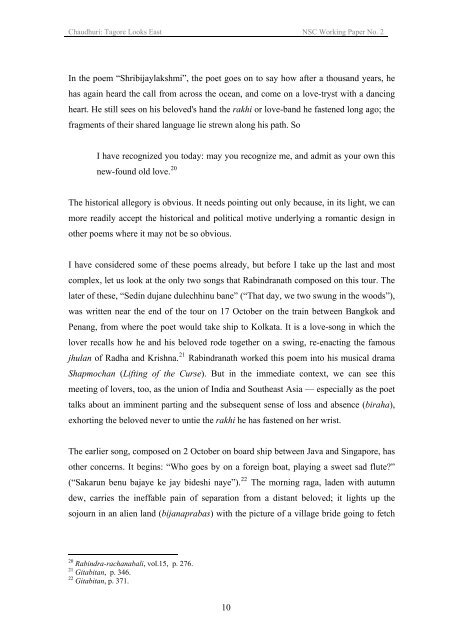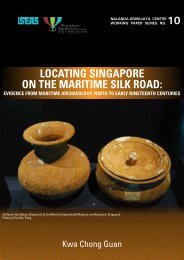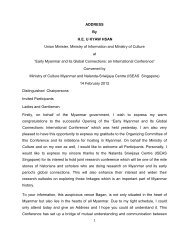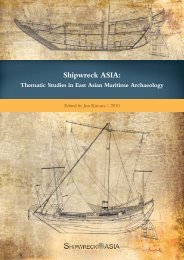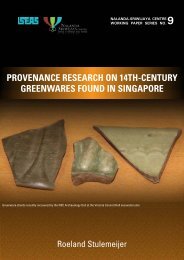2 TAGORE LOOKS EAST - Nalanda-Sriwijaya Centre - iseas
2 TAGORE LOOKS EAST - Nalanda-Sriwijaya Centre - iseas
2 TAGORE LOOKS EAST - Nalanda-Sriwijaya Centre - iseas
- No tags were found...
You also want an ePaper? Increase the reach of your titles
YUMPU automatically turns print PDFs into web optimized ePapers that Google loves.
Chaudhuri: Tagore Looks East NSC Working Paper No. 2In the poem “Shribijaylakshmi”, the poet goes on to say how after a thousand years, hehas again heard the call from across the ocean, and come on a love-tryst with a dancingheart. He still sees on his beloved's hand the rakhi or love-band he fastened long ago; thefragments of their shared language lie strewn along his path. SoI have recognized you today: may you recognize me, and admit as your own thisnew-found old love. 20The historical allegory is obvious. It needs pointing out only because, in its light, we canmore readily accept the historical and political motive underlying a romantic design inother poems where it may not be so obvious.I have considered some of these poems already, but before I take up the last and mostcomplex, let us look at the only two songs that Rabindranath composed on this tour. Thelater of these, “Sedin dujane dulechhinu bane” (“That day, we two swung in the woods”),was written near the end of the tour on 17 October on the train between Bangkok andPenang, from where the poet would take ship to Kolkata. It is a love-song in which thelover recalls how he and his beloved rode together on a swing, re-enacting the famousjhulan of Radha and Krishna. 21 Rabindranath worked this poem into his musical dramaShapmochan (Lifting of the Curse). But in the immediate context, we can see thismeeting of lovers, too, as the union of India and Southeast Asia — especially as the poettalks about an imminent parting and the subsequent sense of loss and absence (biraha),exhorting the beloved never to untie the rakhi he has fastened on her wrist.The earlier song, composed on 2 October on board ship between Java and Singapore, hasother concerns. It begins: “Who goes by on a foreign boat, playing a sweet sad flute?”(“Sakarun benu bajaye ke jay bideshi naye”). 22 The morning raga, laden with autumndew, carries the ineffable pain of separation from a distant beloved; it lights up thesojourn in an alien land (bijanaprabas) with the picture of a village bride going to fetch20 Rabindra-rachanabali, vol.15, p. 276.21 Gitabitan, p. 346.22 Gitabitan, p. 371.10


